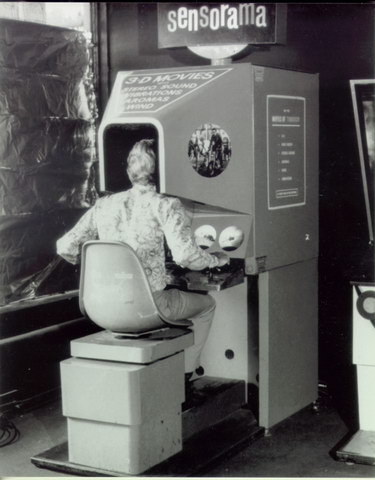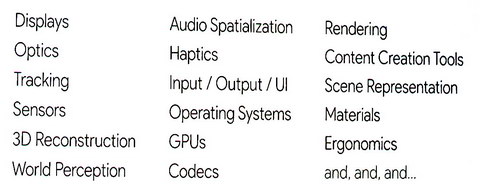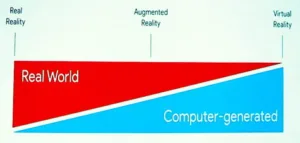Of course, the official name is “Display Week,” not AR/VR Week, but if you were an Augmented Reality (AR) or Virtual Reality (VR) person, there was enough to keep you busy all week long, with no need to look at other display technologies. This was not an accident – SID considered AR/VR a “Special Topic” because of the strong ongoing interest in the technologies.

AR/VR Week started with Short Course S-2 on Sunday, May 21, 2017 which, unfortunately, I could not attend. This was taught by Intel’s Achin Bhowmik from Intel, who also taught the Artificial Intelligence short course Steve Sechrist used as a subject of his Display Daily.
 Sensorama, the first VR experience, from 1962, according to Bhowmik. (Source: Minecraftpsyco – Own work, CC BY-SA 4.0, via Wikipedia)
Sensorama, the first VR experience, from 1962, according to Bhowmik. (Source: Minecraftpsyco – Own work, CC BY-SA 4.0, via Wikipedia)
Bhowmik’s AR/VR short course was titled “Virtual & Augmented Reality: Towards Life-Like Immersive and Interactive Experiences” and started with a little VR history. Even though the focus of Display Week was displays, he discussed multiple non-display issues associated with AR and VR. These included sensing, tracking, computing and interface issues. Two key issues he did not cover were VR and AR content creation and distribution. I guess there is only so much you can cover in a four hour short course.
One of the more interesting things in Bhowmik’s presentation was actually in his “Backup Slides” section. There were 18 different designs for HMD NTE displays, taken from the patent literature, the Journal of Display Technology and SID publications. While some of these were VR displays, most were see-through AR displays. Obviously, there is more than one way to make a NTE display and the industry has not yet settled on the best optical design for these systems, especially for see-through systems.
Standards for AR/VR
Monday of AR/VR week included a full day presentation titled “SID/ICDM Display Metrology Training Course” that included seven different presentations on various aspects of the measurement of displays. Segment W-4 was presented by Tom Lianza, CTO of Photo Research, and was titled “Heads-Up and Near-Eye Display Measurement.” Recently I complained there were no standards for the measurement of AR or VR near-the-eye (NTE) displays. Chris Chinnock of Insight Media, who was Co-Chair of this metrology training course, assured me the International Committee for Display Metrology (ICDM) is, in fact, working on standards for the measurement of NTE displays.
While currently there are no standards, Lianza discussed measurement techniques that would give repeatable, reliable luminance and colorimetry values for NTE displays that would be comparable between different laboratories, e.g. HTC measurements could be compared to Oculus measurements if both followed these prescriptions. He said that AR/VR measurements are not a single issue but involve four display types that have distinctly different measurement problems:
- NTE VR displays with no ambient illumination
- NTE see-through AR displays with some ambient illumination
- NTE Digital Eyeglass AR displays with full ambient illumination
- Head Up Displays (HUDs) for automotive and aircraft applications with full ambient illumination.
For virtual displays, whether NTE or HUDs, Lianza emphasized the importance of controlling the entrance pupil of the measuring instrument relative to the exit pupil and eye box of the display. While waiting for standards to be written, he provided some initial recommendations:
- For Head Up Displays (Avionics/Automotive) use of a standard spectroradiometer is advised with the provision that care is taken to ensure the entrance pupil of the instrument is properly filled.
- For Near Eye Displays the Fixed Aperture method should be used, but a standard spectroradiometer can be used in a stand-off position to ensure the entrance pupil is filled. Correlation between methods will be compromised by display non-uniformity.
- Repeatability measurements should be made, no fewer than seven, to ensure there is not an issue with temporal syncing.
- Reliability measurements should be made to confirm that the measurement process is working.
Since Lianza is going to have a major role in writing the measurement standards for NTE and HUD displays, it is safe to assume that versions of these recommendations will be in the final standard.
Neither Lianza, nor anyone I talked to at AR/VR Week, discussed the measurement of resolution or contrast on NTE displays, only colorimetry and luminance. With four display types and the areas of resolution and contrast essentially untouched, it looks like the ICDM has a lot of work ahead of it to generate these test methods. The ICDM is looking for volunteers to do some of this work – contact Tom Lianza at Photo Research.
Seminars
Also on Monday were two seminars related to AR/VR technology. Unfortunately, not only did I miss them both, I haven’t even seen the notes from them. The first (M-4) was titled “Computational Near-Eye Displays with Focus Cues,” presented by Gordon Wetzstein of Stanford University. The second (M-8) was titled “Light-Field Imaging and Display Systems” presented by Nikhil Balram of Google. In his abstract he says light field imaging has “interesting applications such as AR and VR.” Since computational displays are closely related to light field imaging, this comment applies to Wetzstein’s talk, too. Maybe I had no need to go to these seminars – light field imaging and computational displays for AR and VR were well-represented at the Technical Symposium later in the week.
On Tuesday of AR/VR Week, one of the Keynote Speakers was Clay Bavor, VP of Virtual and Augmented Reality at Google. He emphasized three things – all of which are often ignored by AR/VR enthusiasts but make VR and AR more difficult in practice:
Immersive Computing Spectrum according to Clay Bavor
- AR vs. VR is not a binary issue – there is a continuum from full Reality to full Virtual Reality.
 Clay Bavor’s estimated data throughput needed for true VR
Clay Bavor’s estimated data throughput needed for true VR
- He said resolution of VR displays needs to be increased by at least a factor of 10x to about 20MP/eye to provide “Reality,” a position I fully agree with. This leads to major data throughput issues. If a man from Intel is worried about data throughput rates, we all should be very worried.
 Building Blocks needed for VR and AR systems, according to Bavor
Building Blocks needed for VR and AR systems, according to Bavor
- He mentioned major technology building blocks needed for VR and AR, many skipped by Lianza, and for that matter, by me. All these problems (plus the cost problem) need to be solved before AR/VR can become a mainstream marketplace reality.
Display Week Begins in Earnest
After the keynote speeches, Display Week began in earnest. As part of the technical symposium, which ran from Tuesday morning after the keynote speeches till Friday at noon, there were 49 papers related to AR and VR and I attended most of them.
On Wednesday, separate from the technical symposium, there was a full day AR/VR Business-Track Conference with about 23 speakers. One presentation was a panel discussion on “Representing Reality – Creating the Immersive Experience,” moderated by Meko’s Bob Raikes. This business conference not only provided business forecasts for VR and AR, it discussed business opportunities for the building blocks discussed by Bavor in his keynote speech.
The exhibition also did not miss out on the AR/VR tsunami. I saw several systems designed specifically to measure NTE displays – standards may be coming but people can’t wait and must measure these displays today. There were also displays and materials needed for AR and VR in both the regular exhibition and the I-Zone portion of the exhibition. The I-Zone is designed around start-ups and university research groups that want to reach a wide audience with their technology but cannot afford to exhibit in the normal exhibition space. At times, the I-Zone, with its innovative technology, was busier than the main exhibition floor. (Not that there wasn’t innovative technology on the main show floor!)
In the coming week I’ll be writing up my AR and VR experiences at AR/VR Week, including reports on the Technical Symposium, the AR and VR business conference and AR/VR on the exhibition floor. These reports will be in Meko’s complete report on SID’s Display Week, due out soon. (Subscription required.)
BTW, if SID’s Display Week didn’t satisfy your desire for AR and AR, there will be a lot more during the 8th Annual Augmented World Expo (AWE), scheduled for May 31 – June 2 at the Santa Clara Convention Center in California’s Silicon Valley. – Matthew Brennesholtz

